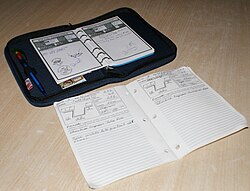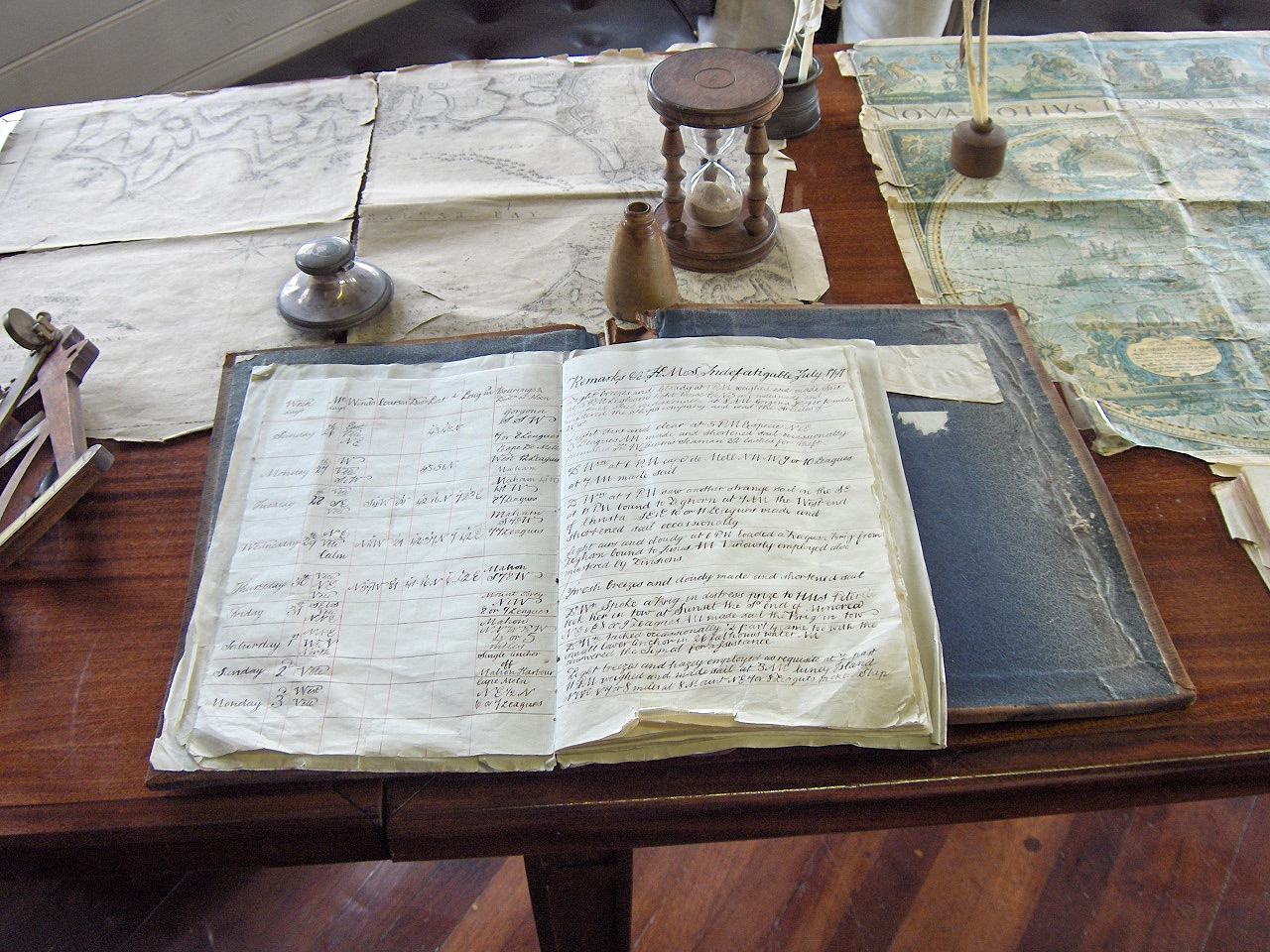Logbook
De Mi caja de notas
Révision datée du 7 février 2020 à 06:27 par Xtof (discussion | contributions) (Page créée avec « {{:wikipedia:logbook}} == journal de bord == {{:journal de bord}} »)


A logbook (or log book) is a record used to record states, events, or conditions applicable to complex machines or the personnel who operate them. Logbooks are commonly associated with the operation of aircraft, nuclear plants, particle accelerators, and ships (among other applications).
The term logbook originated with the ship's log, a maritime record of important events in the management, operation, and navigation of a ship. The captain was responsible for keeping a log, as a minimum, of navigational wind, speed, direction and position.
Format
Logbooks come in many varieties, but they are sometimes standardized in form and/or content within certain organizations or industries. In some applications like flight training or trucking hours of service, they contain specific information used to satisfy legal requirements.
Electronic logbooks
Prior to the advent of mobile computing, logbooks were almost exclusively printed and bound in hard copy form. While physical logbooks offer advantages in frontline applications with many users (like aircraft maintenance logs), the proliferation of cloud computing and mobile devices has enabled the development of electronic logbooks. They may be as complex as software packages, or as simple as editable spreadsheets, but electronic logbooks offer several advantages including virtually unlimited capacity and digital backups.
Applications
Maritime logbooks
To record key navigation, engine watch, port calls and other operational activities on board vessels of all sizes, marine logbooks must meet the specific reporting requirements of IMO, SOLAS and flag states. When maritime logbooks are of the electronic variety, manually-inserted information is normally combined with data recorded from the vessel's instruments such as time and position. Typical marine logbooks are:
- Deck logbook – Records navigational events related to the voyage and operations on board
- Dynamic positioning logbook – Manual recording of operations related to Dynamic Positioning (DP) operations
- Engine logbook – Records engine events related to the engine and machinery operation
- Oil record book – Records events related to oil and dirty water as required by IMO's MARPOL convention[1]
- Operational log – Records events related to vessel operation, i.e. performance, cargo handling and maritime operations. The Operational Log will typically need some customization to owner's requirement and trade.
- Port or harbor logbook – Records incoming and outgoing vessels at a port
- Radio logbook – Records events relevant to radio traffic as required by IMO and the flag states
The maritime industry is increasingly adopting digital logbooks to replace traditional paper-based records, aiming to enhance operational efficiency, ensure compliance with international regulations, and improve data accuracy. A significant development in this field is the creation of ISO 4891: Ships and Marine Technology – Interoperability of Smart Applications for Ships.[2] This standard establishes a framework for the seamless integration of smart applications on vessels, facilitating efficient communication and data exchange between various systems. The standard was developed through a collaboration between DIN, the German Institute for Standardization, and the Japan Ship Technology Research Association[3] and several reputed stakeholders of the maritime industry. The adoption of digital logbooks and the establishment of interoperability standards like ISO 4891 reflect a broader trend towards digital transformation in maritime operations, promoting safer, more efficient, and sustainable shipping practices.
Shift logbooks
On any industrial site, there is a continuous stream of operational, maintenance and safety events occurring at all levels and areas within the process.[4] An electronic shift logbook is used at power plants and in process industry where several shift teams cooperate in maintaining production. Typically the electronic shift logbook is used to record state at the production plant, but it can also contain simple planning functions that notify personnel about upcoming maintenance activities. Compared to the paper logbook the electronic shift logbook enhance the value of the gathered information through;
- Search functions
- Defined plant hierarchy for registration of logbook entries
- Classification according to certain entry types
- Statistics about most problematic areas
- Management reports
Additionally, access to the information storage can be controlled through user authentication and authorizations mechanisms.[5][6]
Manufacturing logbooks
Logbooks have been promoted within manufacturing for reasons including:
- Inventory and process analysis/management
- Quality control
- Maintenance management
- Regulatory and legal compliance where applicable
Other applications
It has since been applied to a variety of other uses, including:
- Aircraft pilots must maintain a pilot logbook to record their time spent flying and in a simulator. In addition, aircraft operators must maintain an aircraft technical logbook (or "tech logs") recording the aircraft's flights, maintenance and defects.
- In a project, a logbook is a recording which is compiled while it is being done may be called a project diary.[10][11] In the PRINCE2 project management framework, daily logs are used to record issues, actions or events not caught by other types of registers or logs within the framework. Examples of other logs or registers in PRINCE2 include the lessons log, risk register, issue register, quality register or backlog.
- In skydiving, a logbook serves as a parachutist's personal history in the sport and also serves as an identifying document. It also provides drop zones proof to back one's skydiving licenses, ratings and currency.[citation needed]
- In scuba diving, the dive log documents the experience of a diver by logging a diver's dives.
- In the fishing industry, a logbook is used to record catch data as part of the fisheries regulations. It is then submitted to the fishing authorities of the vessel's flag state.[citation needed]
- For amateur radio, the logbook is where the hams register their contacts and other radio operations. There are several programs to help radio operators in the management of their logbook.[citation needed]
- For commercial vehicles: In Canada,[12] the United States,[13] New Zealand[14] and other countries, a logbook is used to register driver and operator work time for commercial heavy vehicles. In the United States hours of service are recorded in a logbook. In New Zealand it is referred to as work-time.
- In the United Kingdom, a vehicle registration certificate (V5C) and service history is often referred to as a "logbook".[15]
- A race car log book is a document certifying that a car is prepared to a given set of rules and is safe for competitions.
- Lab notebooks and electronic lab notebooks are used in research and scientific settings.
See also
References
- ^ "proimio pro-ORB - The original e-ORB", proimio, Retrieved on 28 October 2012.
- ^ "ISO 4891:2024". ISO. Retrieved 2025-02-04.
- ^ Japan Ship Technology Research Association
- ^ "j5 Operations Logbook Software - j5 International". j5 International. Retrieved 2016-05-24.
- ^ "ABB shift book product website", ABB Group, Retrieved on 27 July 2015.
- ^ "Fortum TOPi logbook product website", Fortum, Retrieved on 27 July 2015.
- ^ "The Power of eLogbook: Streamlining Manufacturing For Frontline Success". 14 May 2024. Retrieved 2024-06-03.
- ^ "The Essential Guide to Maintenance Logbook". maintboard.com. Retrieved 5 October 2025.
- ^ "Importance of logbook management". veridoclogbook.com. Retrieved 5 October 2025.
- ^ Triant G. Flouris; Dennis Lock (2016), "Case History or Project Diary", Managing Aviation Projects from Concept to Completion, Routledge, p. 484, ISBN 9781317101956
- ^ Nick Graham (2014), "Project Log Checklist", Project Management Checklists For Dummies, John Wiley & Sons, p. 126, ISBN 9781118931431
- ^ Ontario Ministry of Transportation (25 July 2019). "Commercial Vehicle Operators' Safety Manual". www.mto.gov.on.ca/.
- ^ Federal Motor Carrier Safety Administration (17 December 2020). "FMCSA Hours of Service (HOS)". www.fmcsa.dot.gov.
- ^ "Heavy vehicle work time requirements and logbooks". DT Driver Training. Retrieved 2018-04-25.
- ^ "Get a vehicle log book (V5C)".
journal de bord
2019 : Notebook and Journal Report
> I've been keeping a daily journal since 1993. I had my system in place until Blurb arrived with their custom journal/notebook option which I'm loving. A few thoughts on the matter.
Combo Papeterie + DayOne
Depuis (mettre date ici des premiers moleskine et DayOne), je m'organise sur différents carnets en papier (détails sur http://ducamp.me/Fournitures#Carnets_de_notes). Fervent du Leuchturm1917, je cherche une solution alternative pour personnaliser des carnets.
- Un journal de bord créatif à personnaliser soi-même (appli brightwork) http://shifter.media/creative-notebook-and-journal-report/
- Papier Tigre https://www.papiertigre.fr est attendu à la rentrée 2019 sur une UI de personnalisation de carnets
Cet article est une débauche. Vous pouvez m’aider à l'améliorer.
L’article 240-2.07 de la Division 240 décrit le livre de bord comme "un journal de bord contenant les éléments pertinents pour le suivi de la navigation et la sécurité du navire”

Le livre de bord est un ensemble de registres (journal passerelle, journal machine, journal radio)[1] dans lesquels le capitaine ou les officiers d'un navire, consignent chronologiquement les différents événements, manœuvres, caps, observations et paramètres concernant la navigation, la conduite des machines, la réception et l'émission de messages radios. La liste d'équipage est notée dans le journal passerelle. La liste de passagers est un document à part. Le journal passerelle inclut les opérations de chargement-déchargement (y compris les marchandises dangereuses). Un éventuel problème médical est également noté au journal passerelle.
En cas de problème, le livre de bord permet aux inspecteurs ou experts de retracer le déroulement des opérations. Juridiquement, il fait foi jusqu'à preuve du contraire. On lui ajoute fréquemment le journal de mer, dans lequel le capitaine écrit ses rapports de mer. Il peut être complété sur les grands navires par un enregistreur des données du voyage, équivalent maritime des boîtes noires utilisées dans l'aviation, mais reste pour l'heure un élément important de la sécurité maritime. Les navires de petite taille peuvent regrouper les registres en un seul.
- Sur tout navire, le journal de mer prévu par la loi no 69-8 du doit être complété du livre de bord coté. Ce livre qui peut comporter en annexe tout registre requis au terme du présent règlement (exercices, inspections, inventaire…) est visé chaque jour par le capitaine. Le journal passerelle, le journal machine et le journal radio constituent le livre de bord du navire.
- Les faits relatifs à la sécurité du navire en toutes circonstances doivent être consignés par ordre chronologique sur le journal passerelle, ainsi que les conditions météorologiques et tous les événements intéressant la sauvegarde de la vie humaine en mer.
- Les renseignements relatifs à la conduite du navire et à la tenue constante de l’estime doivent y figurer avec précision.
- Le capitaine y inscrit ses consignes journalières à l’usage des officiers de quart sur la passerelle.
- Le livre de bord doit comporter la liste de l'équipage, passagers et cargaison.
- l'heure d'appareillage.
- les prévisions météo et le temps observé et mesures prises.
- le cap suivi et vitesse à intervalles réguliers.
- incidents, panne et avarie à bord.
- Pour la plaisance[2], le livre de bord (nommé journal de bord dans la réglementation Article 240-2.07) fait partie des documents obligatoires (matériel d’armement et de sécurité semi-hauturier).
Notes et références
Voir aussi
